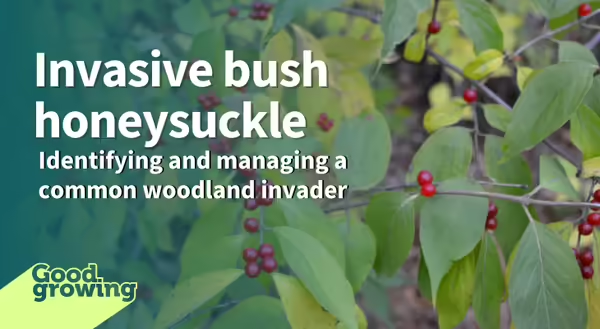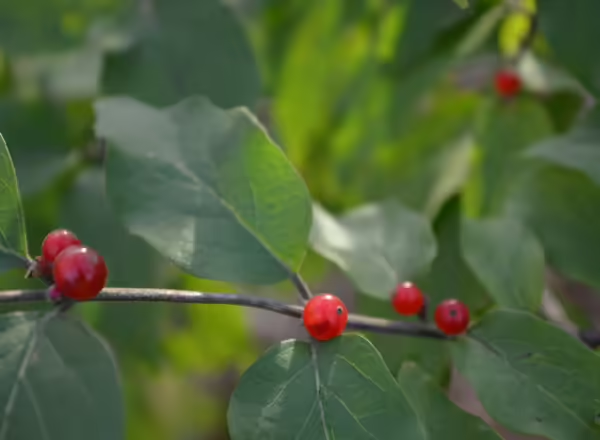
The problem with learning about invasive plants species is once you know about them, you start to see them everywhere. It can be a little depressing. How joyous it was when I began my life in horticulture. Learning about amazing plant processes and all the wonderful plants used in the ornamental landscape. Indeed, at the outset of my botanical life, all plants were good.
In practice, things are quite different. My understanding of the term 'invasive' took shape after learning my first legally invasive plant – bush honeysuckle.
What is bush honeysuckle and where did it come from?
Bush honeysuckle describes a family of shrub-like honeysuckles. The most common invasive honeysuckles in Illinois are Tartarian (Lonicera tatarica), Amur (L. maacki), and Morrow (L. morrow). These plants hail from Europe and Asia and were once recommended for planting as ornamentals, for wildlife cover and food, and erosion control.
“Yet, landowners and researchers have now discovered, these non-native bush honeysuckles are a poorer quality wildlife food source than previously thought. Today, bush honeysuckle is considered one of the biggest threats to our native Illinois ecosystems.”


How to identify bush honeysuckle and where to find it
Bush honeysuckle can be identified due to their opposite leaf arrangement, white spring flowers along the stem, and pairs of typically red fruit in the fall. The center of the stem is hollow, whereas Illinois' single native honeysuckle species has a solid stem.
The best way to find bush honeysuckle is to look into the woods in the late fall or early spring where it can form dense thickets. Honeysuckle can survive in full sun or the shade of a woodland understory and it is the first to leaf out in the spring and last to drop its leaves in the fall.
Why Do We Need to Control Bush Honeysuckle?
Away from their native range without any pressure from insects, disease, or herbivores, these shrubs spread through a forest, choking out native species, and reducing species diversity. The less diverse the plant community, the fewer animals that can be supported, leading to a decline in wildlife populations.
The shrub and herbaceous understory of woodlands vanishes under the blanket of honeysuckle leaves. Leaving behind bare soil that washes into streams and rivers, choking out aquatic life. Overstory trees are not immune to the effects of bush honeysuckle. Research has shown that large trees in forests invaded by bush honeysuckle are stunted by as much as 40 percent!
Controlling bush honeysuckle
Mechanical
Depending on the situation, there are different methods to control honeysuckle. Mechanical control using a saw or loppers to remove stems triggers vigorous growth and is often unsuccessful unless repeated multiple times a year, for many years.
Young bush honeysuckle is surprisingly shallow-rooted and pulls up easily. Simply pull up the young woody shrub, shake off the soil, and suspend the roots in the air so they dry out and the plant dies. Pulled honeysuckle can be piled up, or hung on a nearby tree branch. It is a quick and effective method that doesn’t require heavy equipment or herbicides.
The larger, more established honeysuckle does not pull up so easily. I’d suggest tugging at the plants, and if they don’t budge, just move on. Don’t throw out your back or fly backward on your rear end trying to pull honeysuckle. Most medium-sized plants can be pulled with the assistance of a lever. You can find companies that sell levers designed for pulling honeysuckle or even make one at home. Honeysuckle pullers or poppers come in various forms, but they all operate using the power of leverage.
As for the large, established honeysuckle, you would need a tractor or skid steer to pull it out of the ground, and it would disturb quite a bit of soil in doing so. That’s when we often need to turn to herbicides which is described below.
Yet, for those smaller honeysuckle plants you can make a good dent in their population by pulling them like a weed in a garden.
Some woodlands are so overgrown with bush honeysuckle, that a person cannot even walk through the forest. In this case, most landowners use a skid steer or tractor with a brush-clearing attachment. They then wait for the flush of new growth and can then walk through and spray the new growth with an herbicide as the top growth may be small, but the root system is mighty and can't be pulled by hand.
Fire is another option, but it is not usually well-suited for controlling honeysuckle by itself. It will remove the above-ground growth, but plants will often resprout from the root system. A hot slow-burning fire may be more effective at killing honeysuckle, however, it will also cause more damage to desirable trees, shrubs, and herbaceous plants.
Biological
Using other organisms to help control honeysuckle requires additional study. One common technique is enlisting goats to help eat honeysuckle. While this seems like a great way to raise goats and control honeysuckle, there are some important considerations.
- Even in Illinois goats are under threat from predators, namely coyotes. Areas using goats will require protective fencing which typically will involve brush cutting to clear a path for the fence. This can be very labor intensive.
- Goats need to be fed more than just honeysuckle. The shrub alone will not provide all the nutrition a growing goat needs. Additional feed needs to be supplied sometimes daily.
- Goats aren't very selective on what they eat and will often strip all the vegetation in reach. Any plants or small trees you want to save need to be protected.
- The honeysuckle will resprout from the roots to resume their woodland domination. If you had a permanent goat herd it may make more of a difference. However, when turning to goats, many landowners will need to rent a herd, which makes it too cost-prohibitive for a long-term solution, especially when dealing with acres and acres of land.
Chemical
In most situations, a landowner will turn to herbicides to control bush honeysuckle. Many use the cut-stump technique, where one person cuts the honeysuckle six inches from the ground and a second paints the stump with a 25 to 50 percent concentration of glyphosate herbicide mixed in water or triclopyr amine in water or ester in oil at a 20 to 25 percent within 10 minutes of cutting. The second option is a foliar spray with a 2 to 4 percent concentration glyphosate in water. Either technique is best performed in the fall when the plant is sending energy to the root system and bush honeysuckle is one of the only shrubs with leaves making it easy to identify. Unfortunately, once you learn this plant you'll start seeing it everywhere.
There is a lot more when it comes to controlling bush honeysuckle and promoting native understory plants. Contact your local Extension office for more information on invasive plant species. Illinois Extension has lots more information online when it comes to controlling bush honeysuckle and many other invasive species in our Management of Invasive Plants and Pests of Illinois.
Sign up for our emails! Want to get notified when new Good Growing posts are available? SIGN ME UP
Give us feedback! How helpful was this information (click one): Very helpful | Somewhat helpful | Not very helpful
MEET THE AUTHOR
Chris Enroth is a horticulture educator with University of Illinois Extension, serving Henderson, McDonough, Knox, and Warren counties since 2012. Chris provides horticulture programming with an emphasis on the home gardener, landscape maintenance personnel, and commercial landscapers. Additional responsibilities include coordinating local county Master Gardener and Master Naturalist volunteers - providing their training, continuing education, advanced training, seasonal events, and organizing community outreach programs for horticulture and conservation assistance/education. In his spare time, Chris enjoys the outdoors, lounging in the garden among the flowers (weeds to most).